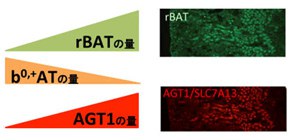
Transporter protein involved in renal reabsorption of cystine found
Will lead to new treatment methods for cystinuria
An international research group clarified that AGT1/SLC7A13, a membrane protein in kidneys, is identified as a transporter protein involved in renal reabsorption of cystine.
AGT1 is an unknown factor that binds with the protein rBAT/SLC3A2, whose mutations may cause cystinuria leading to serious kidney failure. The group demonstrated the possibility that changes in AGT1 may contribute to the development of cystinuria.
This achievement may lead to the development of new therapeutic methods for cystinuria.
Cystinuria occurs in one out of every 7,000 in the world, one out of every 10,000 -20,000 in Japan, but its curative treatment has not been established. AGT1/SLC7A13, a protein, is an unknown factor that binds with the protein rBAT/SLC3A2, of which mutations may cause cystinuria leading to serious kidney failure.
A research group led by Shushi Nagamori, Associate Professor, and Yoshikatsu Kanai, Professor, at Osaka University, in collaboration with The Institute for Research in Biomedicine (IRB Barcelona), and Tokyo Medical and Dental University clarified that AGT1 is identified as a transporter protein involved in renal reabsorption of cystine.
This group demonstrated the possibility that changes in AGT1 may contribute to the development of cystinuria.
By using a new technology which combines a method for identifying proteins using a mass spectrometer with a classic biochemical method for analyzing transport activity of proteoliposome reconstituted from purified proteins, this group identified AGT1 as the second partner of rBAT in the S3 segment of renal proximal tubules in mice.
Furthermore, this group clarified that complexes of AGT1 and rBAT transport cystine and acidic amino acids (aspartic acid, glutamic acid) and demonstrated that AGT1 and rBAT are the second cystine transporter. The identification of this second cystine transporter in proximal tubules has answered long-lasting mystery regarding cystine reabsorption.
This group's achievement may lead to the clarification of the whole picture of cystine absorption and the development of new therapeutic methods for cystinuria.

Figure: Kidney consists of many renal tubules. Primary urine is formed by filtration from the blood in glomerulus and excreted via renal tubules as urine.
AGT1 is present at renal tubules and reabsorb cystine and other amino acids from urine.
---
Proceedings of the National Academy of Sciences of the United States of America
Authors:Nagamori S, Wiriyasermkul P, Espino Guarch M, Okuyama H, Nakagomi S, Tadagaki K, Nishinaka Y, Bodoy S, Takafuji K, Okuda S, Kurokawa J, Ohgaki R, Nunes V, Palacín M, Kanai Y.
Title: Novel cystine transporter in renal proximal tubule identified as a missing partner of cystinuria-related plasma membrane protein rBAT/SLC3A1. Proc. Natl. Acad. Sci. USA 2016 Jan 19;113(3):775-80. Doi: 10.1073/pnas.1519959113
Funded in part by a Grant-in-Aid for Scientific Research on Priority Areas of ‘Transportsome’ (Y.K.) and Innovative Areas ‘HD Physiology’ (Sh.N.) from the Ministry of Education, Culture, Sports, Science and Technology of Japan; Grants-in-Aid for Scientific Research (Y.K., Sh.N.) from the Japan Society for the Promotion of Science; a research grant from Japanese Society on Urolithiasis Research (Sh.N.); Spanish Ministry of Science and Innovation Grant SAF2012-40080-C02-01-FEDER (M.P.); Spanish Health Institute Carlos III Grant FIS PI13/00121-FEDER (V.N.); and the Generalitat de Catalunya Grants SGR2009-1490 (V.N.) and SGR2009-1355 (M.P.).
To learn more about this research, please view the full research report entitled " Novel cystine transporter in renal proximal tubule identified as a missing partner of cystinuria-related plasma membrane protein rBAT/SLC3A1 " at this page of the PNAS website.
Related link
